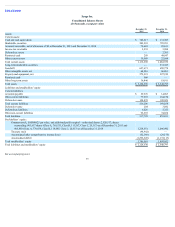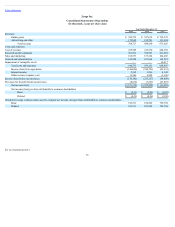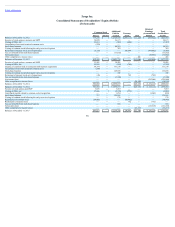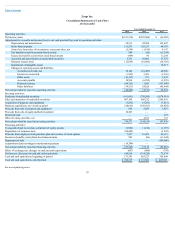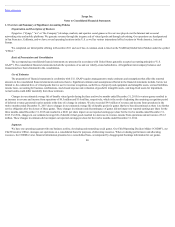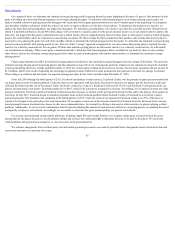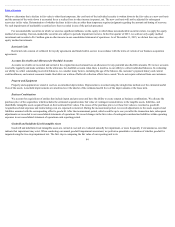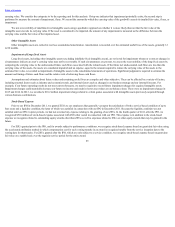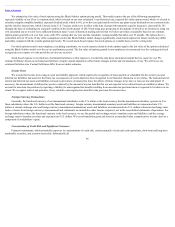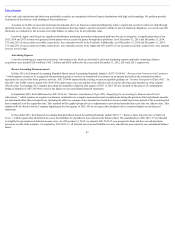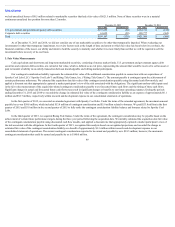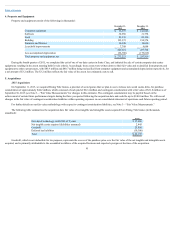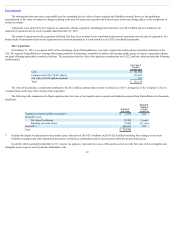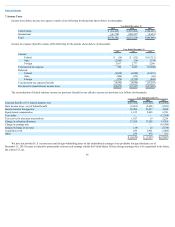Zynga 2015 Annual Report Download - page 88
Download and view the complete annual report
Please find page 88 of the 2015 Zynga annual report below. You can navigate through the pages in the report by either clicking on the pages listed below, or by using the keyword search tool below to find specific information within the annual report.
Table of Contents
carrying value. We consider the enterprise to be the reporting unit for this analysis. If step one indicates that impairment potentially exists, the second step is
performed to measure the amount of impairment, if any. We record the amount by which the carrying value of the goodwill exceeds its implied fair value, if any, as
impairment.
We test recoverability of indefinite-lived intangible assets using a qualitative approach on whether it is more likely than not that the fair value of the
intangible asset exceeds its carrying value. If the asset is considered to be impaired, the amount of any impairment is measured as the difference between the
carrying value and the fair value of the impaired asset.
OtherIntangibleAssets
Other intangible assets are carried at cost less accumulated amortization. Amortization is recorded over the estimated useful lives of the assets, generally 12
to 60 months.
ImpairmentofLong-LivedAssets
Long-lived assets, including other intangible assets (excluding indefinite-lived intangible assets), are reviewed for impairment whenever events or changes in
circumstances indicate an asset’s carrying value may not be recoverable. If such circumstances are present, we assess the recoverability of the long-lived assets by
comparing the carrying value to the undiscounted future cash flows associated with the related assets. If the future net undiscounted cash flows are less than the
carrying value of the assets, the assets are considered impaired and an expense, equal to the amount required to reduce the carrying value of the assets to the
estimated fair value, is recorded as impairment of intangible assets in the consolidated statements of operations. Significant judgment is required to estimate the
amount and timing of future cash flows and the relative risk of achieving those cash flows.
Assumptions and estimates about future values and remaining useful lives are complex and often subjective. They can be affected by a variety of factors,
including external factors such as industry and economic trends, and internal factors such as changes in our business strategy and our internal forecasts. For
example, if our future operating results do not meet current forecasts, we may be required to record future impairment charges for acquired intangible assets.
Impairment charges could materially decrease our future net income and result in lower asset values on our balance sheet. There were no impairment charges in
2015 and 2014. In 2013, we recorded a $10.2 million impairment charge related to certain games associated with intangible assets previously acquired through
various business combinations.
Stock-BasedExpense
Prior to our IPO in December 2011, we granted ZSUs to our employees that generally vest upon the satisfaction of both a service-based condition of up to
four years and a liquidity condition, the latter of which was satisfied in connection with our IPO in December 2011. Because the liquidity condition was not
satisfied until our IPO, in prior periods, we had not recorded any expense relating to the granting of our ZSUs. In the fourth quarter of 2011, after the IPO, we
recognized $510 million of stock-based expense associated with ZSUs that vested in connection with our IPO. This expense is in addition to the stock-based
expense we recognize related to outstanding equity awards other than ZSUs as well as expenses related to ZSUs or other equity awards that may be granted in the
future.
For ZSUs granted prior to the IPO, and for awards subject to performance conditions, we recognize stock-based expense based on grant date fair value using
the accelerated attribution method in which compensation cost for each vesting tranche in an award is recognized ratably from the service inception date to the
vesting date for that tranche. For ZSUs granted after the IPO, which are only subject to a service condition, we recognize stock-based expense based on grant date
fair value on a ratable basis over the requisite service period for the entire award.
85


